
06/02/2011
Movies Home / Entertainment Channel / Bullz-Eye Home
Ultraviolence – the word, not the idea – was invented in 1962 when Anthony Burgess published his novel, “A Clockwork Orange.” While the book may have raised some eyebrows, reading about the atrocities perpetrated by teen thug Alex and his droogies was one thing; seeing them committed to the big screen by master cinema stylist Stanley Kubrick was quite another. Allegations of copycat crimes followed and the controversy eventually grew so frightening that the film was withdrawn from circulation in England for 27 years, apparently at Mr. Kubrick's request. Meanwhile in the U.S., it was one of only two productions to receive both an X rating and a Best Picture Oscar nomination. Today, we have another word for "ultraviolence" – just another Saturday night at the movies.
Now that a new 40th Anniversary Blu-ray edition of Kubrick's "A Clockwork Orange" is upon us, it seems like a good time to take a look back at what was once considered extreme film violence and what still is considered the outer limits of what you can, or should want to, show on a motion picture or television screen. Yes, graphic violence in major productions had been exploding since the moment Alfred Hitchcock blindsided audiences with the "Psycho" shower scene in 1960. It would take some time before the kind of extreme shocks once sought out only by the hardiest of grindhouse horror fans could be seen by anyone with a subscription to basic cable.
Stay with us now, as somewhat squeamish but ever-fascinated cinema chicken Bob Westal and hardened connoisseur of the horrific Ross Ruediger take you on a journey through movies that were once called "ultraviolent," movies that are still pretty ultraviolent, and movies that are something well past that. We'll move from a time when the death of a couple of pretty and sympathetic gangsters shocked the sensibilities of many, to the present moment when truly shocking an audience seems to require an ultra-twisted imagination. Viddy this."Bonnie and Clyde" (1967)
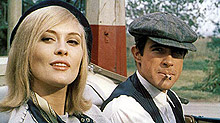 "This is Bonnie. This is Clyde. They're young. They're in love. They kill people." So went the Roy Lichtenstein-inspired title cards promoting the fact-inspired gangster tragedy starring the glamorous-yet-vulnerable pair of Warren Beatty and Faye Dunaway. Nationwide, college students flocked to check it out and young teens fought with their parents for the right to see it. New York Times critic Bosley Crowther famously waged a one-man campaign against "Bonnie and Clyde," railing against its brutality and vulgarity as the ticket sales and Oscar nominations came in. Looking at the film today, which features what amounts to a few moments of bracingly realistic and deglamorized screen violence and mainstream Hollywood's first discrete allusion to oral sex, younger viewers might find it a little hard to see what the fuss was about. It's important to remember that, even among film critics, "Psycho" had been the maximum in screen shock. That movie was in black and white, and its "graphic" violence was something of a cinematic trick, if you could stand to look closely. On "Bonnie and Clyde," director Arthur Penn gave us some pretty realistic bloodletting in full color and allowed us to feel the pain of the people who were its object. The back-to-back juxtaposition of humor and bloody violence, a common convention of today's gangster and noir pictures, was another shocking innovation. Then, there was the politics of it. For some, Bonnie and Clyde were stand-ins for the violent leftwing or anarchist insurrection many conservative and even some not-so-conservative adults actually feared in the late ‘60s. Now that's some scary ultraviolence. – BW
"This is Bonnie. This is Clyde. They're young. They're in love. They kill people." So went the Roy Lichtenstein-inspired title cards promoting the fact-inspired gangster tragedy starring the glamorous-yet-vulnerable pair of Warren Beatty and Faye Dunaway. Nationwide, college students flocked to check it out and young teens fought with their parents for the right to see it. New York Times critic Bosley Crowther famously waged a one-man campaign against "Bonnie and Clyde," railing against its brutality and vulgarity as the ticket sales and Oscar nominations came in. Looking at the film today, which features what amounts to a few moments of bracingly realistic and deglamorized screen violence and mainstream Hollywood's first discrete allusion to oral sex, younger viewers might find it a little hard to see what the fuss was about. It's important to remember that, even among film critics, "Psycho" had been the maximum in screen shock. That movie was in black and white, and its "graphic" violence was something of a cinematic trick, if you could stand to look closely. On "Bonnie and Clyde," director Arthur Penn gave us some pretty realistic bloodletting in full color and allowed us to feel the pain of the people who were its object. The back-to-back juxtaposition of humor and bloody violence, a common convention of today's gangster and noir pictures, was another shocking innovation. Then, there was the politics of it. For some, Bonnie and Clyde were stand-ins for the violent leftwing or anarchist insurrection many conservative and even some not-so-conservative adults actually feared in the late ‘60s. Now that's some scary ultraviolence. – BW
"The Wild Bunch" (1969)
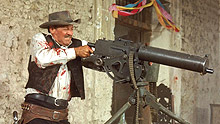 "If they move, kill 'em!" Bonnie and Clyde had their issues, Lord knows, but they were clean and adorable and, if they'd had their druthers, they wouldn't have hurt a fly. You can't quite say that about anyone here. This nightmare western opens with an absolutely unprecedented bloodbath. As a gang of immoral outlaws led by the ruthless but relatively honorable Pike Bishop (William Holden) attempts a robbery, the whole affair turns out to be an ambush set up the movie's true villains – the railroad – and Bishop's reluctant ex-partner, Deke Thornton (Robert Ryan). As two groups of desperate gunmen go at each other, no one seems to care that scores of civilians are being caught in the crossfire; the camera does not discretely cut away any more than Bishop considers surrendering to save the lives of innocent women and children. Director Sam Peckinpah became instantly synonymous with "excessive" violence through the bloody, slow-motion deaths he choreographed in this film, which went as far as anyone dared in bringing the carnage that was currently going on in the Vietnam War to the movie screen. Today, of course, "The Wild Bunch" is seen mainly as a really great western, which it most certainly is. Still, if you think about it, you should be a little scared by it. Is it an examination of the pointlessness of violence, or a celebration of it? Does it even matter? – BW
"If they move, kill 'em!" Bonnie and Clyde had their issues, Lord knows, but they were clean and adorable and, if they'd had their druthers, they wouldn't have hurt a fly. You can't quite say that about anyone here. This nightmare western opens with an absolutely unprecedented bloodbath. As a gang of immoral outlaws led by the ruthless but relatively honorable Pike Bishop (William Holden) attempts a robbery, the whole affair turns out to be an ambush set up the movie's true villains – the railroad – and Bishop's reluctant ex-partner, Deke Thornton (Robert Ryan). As two groups of desperate gunmen go at each other, no one seems to care that scores of civilians are being caught in the crossfire; the camera does not discretely cut away any more than Bishop considers surrendering to save the lives of innocent women and children. Director Sam Peckinpah became instantly synonymous with "excessive" violence through the bloody, slow-motion deaths he choreographed in this film, which went as far as anyone dared in bringing the carnage that was currently going on in the Vietnam War to the movie screen. Today, of course, "The Wild Bunch" is seen mainly as a really great western, which it most certainly is. Still, if you think about it, you should be a little scared by it. Is it an examination of the pointlessness of violence, or a celebration of it? Does it even matter? – BW
"The Godfather" (1972)
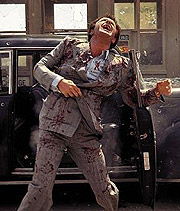 Since "A Clockwork Orange" had rocked cinemas the prior year and Stanley Kubrick himself had declared the film version of Mario Puzo's rather poorly-regarded gangster bestseller as possibly the greatest movie ever made, it was only too easy to tag this Oscar-winning blockbuster and instant classic as ultraviolent. What "The Godfather" really accomplished, however, was to begin the mainstreaming of blunt depictions of brutal violence. While the notorious horse's head scene upset both the squeamish and animal lovers in the audience (the equine cranium was real and purchased from a dog food company), the controversy was muted by the fact that the audience was completely sold on the film's epic soap opera of a story. The shock of the death of Sonny Corleone (James Caan) was not just about the fact that it one-upped the multi-machine-gun ending of "Bonnie and Clyde," but that the audience was sorry to see the somewhat lovable hothead and killer buy the farm. Yes, the closing aria of brutality in which Michael Corleone (Al Pacino) settles old scores and consolidates his power was masterful cinema, but what the audience really cared about was less about this or that bloody death than about the Corleones emerging triumphant. The violence, as blunt as it was, was really just a means to a storytelling end, and was starting to be not that big of a deal. That was a big deal. – BW
Since "A Clockwork Orange" had rocked cinemas the prior year and Stanley Kubrick himself had declared the film version of Mario Puzo's rather poorly-regarded gangster bestseller as possibly the greatest movie ever made, it was only too easy to tag this Oscar-winning blockbuster and instant classic as ultraviolent. What "The Godfather" really accomplished, however, was to begin the mainstreaming of blunt depictions of brutal violence. While the notorious horse's head scene upset both the squeamish and animal lovers in the audience (the equine cranium was real and purchased from a dog food company), the controversy was muted by the fact that the audience was completely sold on the film's epic soap opera of a story. The shock of the death of Sonny Corleone (James Caan) was not just about the fact that it one-upped the multi-machine-gun ending of "Bonnie and Clyde," but that the audience was sorry to see the somewhat lovable hothead and killer buy the farm. Yes, the closing aria of brutality in which Michael Corleone (Al Pacino) settles old scores and consolidates his power was masterful cinema, but what the audience really cared about was less about this or that bloody death than about the Corleones emerging triumphant. The violence, as blunt as it was, was really just a means to a storytelling end, and was starting to be not that big of a deal. That was a big deal. – BW
“The Last House on the Left” (1972) / “I Spit on Your Grave” (1978)
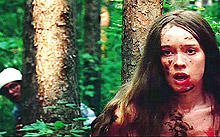 Although there was a six-year period in between their releases, these legendarily excessive revenge tales represent two sides of the same horrific coin. Both films feature filthy, realistic rapes of women in their first halves, followed by a second half of borderline cartoonish retribution met upon the perpetrators. Rape is ugly no matter how it’s portrayed, but both of these movies go out of their way to make it exceedingly painful to watch. In fact, the rape scenes are so disturbingly brutal that the sequences of straight-up violence that come after them practically pale in comparison. That said, both films feature nasty scenes of damage done to male genitalia that, at least for men, make very painful viewing, no matter how you slice them.
Although there was a six-year period in between their releases, these legendarily excessive revenge tales represent two sides of the same horrific coin. Both films feature filthy, realistic rapes of women in their first halves, followed by a second half of borderline cartoonish retribution met upon the perpetrators. Rape is ugly no matter how it’s portrayed, but both of these movies go out of their way to make it exceedingly painful to watch. In fact, the rape scenes are so disturbingly brutal that the sequences of straight-up violence that come after them practically pale in comparison. That said, both films feature nasty scenes of damage done to male genitalia that, at least for men, make very painful viewing, no matter how you slice them.
“The Texas Chainsaw Massacre” (1974)
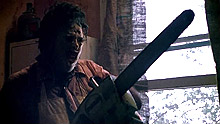 It’s tough to pick just one film that paved the way for how modern horror violence is portrayed, but we’re going to go with Tobe Hooper’s original “Chainsaw” entry. (Sorry, “Halloween” devotees.) Here’s a film that stands the test of time and towers above and over all the sequels, remakes, and rip-offs that have dared to hijack the noted mechanical tool for their titles since. With all that's come after, however, it might be difficult to wrap one's brain around how nightmarish this piece must have felt back in the mid-‘70s. Filmed with a gritty, documentary-like feel and a sense of ever-escalating strangeness, its story of innocent teens (one in a wheelchair) that end up at house of cannibalistic horrors, must surely have kept people away from the Texas countryside in much the same way “Jaws” kept people out of the water. Despite the fact that the film doesn’t feature an immense amount of gore, the tone of the piece – alongside the heartless actions of its villainous central family, including the now-iconic Leatherface – still makes for grueling viewing. You’ll never look at meat hooks the same way again, and family dinner may just take on a whole new meaning as well. – RR
It’s tough to pick just one film that paved the way for how modern horror violence is portrayed, but we’re going to go with Tobe Hooper’s original “Chainsaw” entry. (Sorry, “Halloween” devotees.) Here’s a film that stands the test of time and towers above and over all the sequels, remakes, and rip-offs that have dared to hijack the noted mechanical tool for their titles since. With all that's come after, however, it might be difficult to wrap one's brain around how nightmarish this piece must have felt back in the mid-‘70s. Filmed with a gritty, documentary-like feel and a sense of ever-escalating strangeness, its story of innocent teens (one in a wheelchair) that end up at house of cannibalistic horrors, must surely have kept people away from the Texas countryside in much the same way “Jaws” kept people out of the water. Despite the fact that the film doesn’t feature an immense amount of gore, the tone of the piece – alongside the heartless actions of its villainous central family, including the now-iconic Leatherface – still makes for grueling viewing. You’ll never look at meat hooks the same way again, and family dinner may just take on a whole new meaning as well. – RR
“Deep Red” (1975) / “Suspiria” (1976)
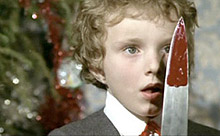 Italian writer/director Dario Argento was one of the pioneers of giallo, a popular Italian film style marked by littering a mystery storyline with all manner of excessive violence. Arguably the most famous of these is “Deep Red,” which features a music teacher (David Hemmings) who stumbles into a series of murders committed by a shadowy, hatchet-wielding figure. Although “Deep Red” remains one Argento's most popular films, it was his next movie that broke from the formula and brought Argento the most acclaim and success. “Suspiria” focuses on a coven of witches operating out of girl’s dance academy in Germany, where Suzy Banyon (Jessica Harper) is taking lessons. The movie sports incredible lighting choices, a killer soundtrack by Argento's band, Goblin, and one memorable death after another. The blood runs fast and furious, but always with a hyperreal, cinematic sheen. Its tagline – “The Only Thing More Terrifying Than The Last 12 Minutes Of This Film Are The First 92” – didn’t tell any lies. Rumors persist of a remake by David Gordon Green starring Natalie Portman, although we can’t imagine what the point of such an exercise would be. "Suspiria" is nearly perfect as is. – RR
Italian writer/director Dario Argento was one of the pioneers of giallo, a popular Italian film style marked by littering a mystery storyline with all manner of excessive violence. Arguably the most famous of these is “Deep Red,” which features a music teacher (David Hemmings) who stumbles into a series of murders committed by a shadowy, hatchet-wielding figure. Although “Deep Red” remains one Argento's most popular films, it was his next movie that broke from the formula and brought Argento the most acclaim and success. “Suspiria” focuses on a coven of witches operating out of girl’s dance academy in Germany, where Suzy Banyon (Jessica Harper) is taking lessons. The movie sports incredible lighting choices, a killer soundtrack by Argento's band, Goblin, and one memorable death after another. The blood runs fast and furious, but always with a hyperreal, cinematic sheen. Its tagline – “The Only Thing More Terrifying Than The Last 12 Minutes Of This Film Are The First 92” – didn’t tell any lies. Rumors persist of a remake by David Gordon Green starring Natalie Portman, although we can’t imagine what the point of such an exercise would be. "Suspiria" is nearly perfect as is. – RR
"Dawn of the Dead" (1978)
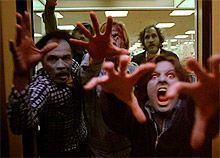 We certainly could have included the 1968 cannibal zombie masterpiece "Night of the Living Dead" as one of the films above that opened the door to extreme violence. Still, as gory and unhinged and genuinely terrifying as it was by the standards of its day, its impact on mainstream movie violence was limited compared to the more extravagant follow-up George Romero made a decade later. Combining extreme violence and gore, with a mastery of the cinema of tension and some pretty clever social satire, Romero made splatter violence acceptable in a way it simply hadn't been prior. Of course, not everybody was on board. It took your humble writer nearly three decades and no small amount of alcohol to finally watch it, but by then zombies had started to become downright cuddly. In a world where famed critic Manohla Dargis could call Zack Snyder's "Dawn" remake "good zombie fun," where AMC's "The Walking Dead" may well be a serious Emmy contender, and where "Shaun of the Dead," "Zombieland," and the upcoming "Pride and Prejudice with Zombies" have been part of a decades-long trend of exploiting the mirthful side of cannibal zombies, well, you've just got to wonder how long anything remotely supernatural can remain shocking or controversial. – BW
We certainly could have included the 1968 cannibal zombie masterpiece "Night of the Living Dead" as one of the films above that opened the door to extreme violence. Still, as gory and unhinged and genuinely terrifying as it was by the standards of its day, its impact on mainstream movie violence was limited compared to the more extravagant follow-up George Romero made a decade later. Combining extreme violence and gore, with a mastery of the cinema of tension and some pretty clever social satire, Romero made splatter violence acceptable in a way it simply hadn't been prior. Of course, not everybody was on board. It took your humble writer nearly three decades and no small amount of alcohol to finally watch it, but by then zombies had started to become downright cuddly. In a world where famed critic Manohla Dargis could call Zack Snyder's "Dawn" remake "good zombie fun," where AMC's "The Walking Dead" may well be a serious Emmy contender, and where "Shaun of the Dead," "Zombieland," and the upcoming "Pride and Prejudice with Zombies" have been part of a decades-long trend of exploiting the mirthful side of cannibal zombies, well, you've just got to wonder how long anything remotely supernatural can remain shocking or controversial. – BW
“Scanners” (1981) / “Videodrome” (1983) / “Blue Velvet” (1986)
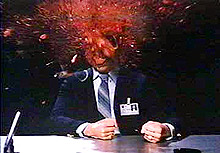 The influence on violent cinema of the work of two directing Davids – Cronenberg and Lynch – can’t be stressed enough. Cronenberg led the way to "body horror" with disturbing cult fare like “Shivers” (1975) and “Rabid” (1977), but it wasn’t until “Scanners” that he started making some serious mainstream headway. Scanners are people with telekinetic abilities, and those abilities generate interest from people with power. The film’s most infamous image was an exploding head, which is kind of how people felt after watching the popular horror-sci-fi flick back in the day. Two years later, Cronenberg followed it up with “Videodrome,” which became almost a visual anthem for late night cable TV in the 80s. Set in the seedy world of unrestricted UHF broadcasting, “Videodrome” featured violence, torture, snuff video, and S&M. Its leads, James Woods and Blondie vocalist Debbie Harry, were asked to play out all manner of perversities, that, admittedly, may seem fairly tame by today’s standards, but at the time broke major ground.
The influence on violent cinema of the work of two directing Davids – Cronenberg and Lynch – can’t be stressed enough. Cronenberg led the way to "body horror" with disturbing cult fare like “Shivers” (1975) and “Rabid” (1977), but it wasn’t until “Scanners” that he started making some serious mainstream headway. Scanners are people with telekinetic abilities, and those abilities generate interest from people with power. The film’s most infamous image was an exploding head, which is kind of how people felt after watching the popular horror-sci-fi flick back in the day. Two years later, Cronenberg followed it up with “Videodrome,” which became almost a visual anthem for late night cable TV in the 80s. Set in the seedy world of unrestricted UHF broadcasting, “Videodrome” featured violence, torture, snuff video, and S&M. Its leads, James Woods and Blondie vocalist Debbie Harry, were asked to play out all manner of perversities, that, admittedly, may seem fairly tame by today’s standards, but at the time broke major ground.
David Lynch’s early work had its sick side, but it kept hidden the violent darkness to come. The floodgates of his demented psyche opened up, however, with the release of “Blue Velvet,” hailed by many as one of the greatest films of the 80s. The murder/kidnapping mystery plays like a moving Norman Rockwell painting for much of the first hour, and then Dennis Hopper’s Frank Booth enters the picture and the film becomes a waking nightmare. The abuse which both Dorothy Vallens (Isabella Rossellini) and Jeffrey Beaumont (Kyle McLachlan) suffer at the hands of Booth is as shocking today as it was then. Both directing Davids have continued making thrilling, violent fare over the years, including “The Fly” and “A History of Violence” (Cronenberg), and “Wild at Heart” and “Lost Highway” (Lynch). – RR
"Hellraiser" (1987)
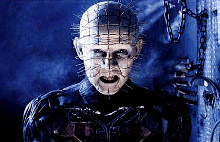 Throughout the 80s, pop horror cinema was ruled by the “Halloween,” “Friday the 13th,” and “A Nightmare on Elm Street” franchises. These fun popcorn films fostered cozy date nights for folks over the age of 17, but one can hardly say that any of them pushed envelopes as far as screen violence is concerned; they represented the mainstreaming of blood and gore, which is, no doubt, why they were so immensely popular. It wasn’t until author turned writer-director Clive Barker came along later in the decade with his fiercely decadent, but modestly budgeted, tale of sadomasochistic pleasure and pain that horror found a new and disturbing face. While Freddy lived in your nightmares, the creepy Cenobites answered the pleas of the hedonistic from a shadowy dimension of terror, and they were perfectly willing to rip the skin from your body, and the muscle from your bones. Much like the aforementioned franchises, “Hellraiser” was eventually beaten to death by at least a half dozen other filmmakers; few grasped the concept with as much intelligence and wit as Barker did on the first outing. Yet, some props must be given to “Hellbound: Hellraiser II” (1988) for offering up a worthy expansion of the concept which wasn’t entirely a waste of time. – RR
Throughout the 80s, pop horror cinema was ruled by the “Halloween,” “Friday the 13th,” and “A Nightmare on Elm Street” franchises. These fun popcorn films fostered cozy date nights for folks over the age of 17, but one can hardly say that any of them pushed envelopes as far as screen violence is concerned; they represented the mainstreaming of blood and gore, which is, no doubt, why they were so immensely popular. It wasn’t until author turned writer-director Clive Barker came along later in the decade with his fiercely decadent, but modestly budgeted, tale of sadomasochistic pleasure and pain that horror found a new and disturbing face. While Freddy lived in your nightmares, the creepy Cenobites answered the pleas of the hedonistic from a shadowy dimension of terror, and they were perfectly willing to rip the skin from your body, and the muscle from your bones. Much like the aforementioned franchises, “Hellraiser” was eventually beaten to death by at least a half dozen other filmmakers; few grasped the concept with as much intelligence and wit as Barker did on the first outing. Yet, some props must be given to “Hellbound: Hellraiser II” (1988) for offering up a worthy expansion of the concept which wasn’t entirely a waste of time. – RR
"Reservoir Dogs" (1992)
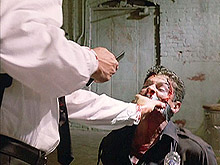 By the early 1990s, followers of extreme cinema might well have declared that just about every frontier of extreme violence had been crossed – but they would have been forgetting the Sundance Film Festival. When Quentin Tarantino's caper-gone-wrong first debuted, attention focused on two areas: 1. This Tarantino kid could really write, direct, and borrow (not that's there anything wrong with that!). 2. A certain torture scene involving an especially sadistic, slave-to-the-rhythm Michael Madsen, a vulnerable cop (Kirk Baltz), a straight razor, and the 70's pop hit, "Stuck in the Middle With You." Never mind that a gut-shot, blood-drenched Tim Roth spends most of the movie in a state of extremely well-acted pain. The movie as a whole was intense enough that Tarantino had to address the issue of a noticeable number of screening walk-outs, including two men who are not exactly strangers to edgy movie violence – Wes Craven (see "Last House on the Left" above) and master make-up artist Rick Baker ("An American Werewolf in London," for starters). It was easily the year's most notable controversial film because of a few minutes of screen cruelty that dared to make torture and mayhem look painful. Not long after, Tarantino's "Pulp Fiction," "True Romance," and Oliver Stone's rewritten version of his "Natural Born Killers" would be labeled "nightmares of depravity" by Republican presidential candidate Bob Dole. Within 15 years, however, a grim film comprised primarily of the torture and death of a single individual would become a worldwide smash and a film no politician dared criticize. The man in that film was, of course, Jesus Christ. – BW
By the early 1990s, followers of extreme cinema might well have declared that just about every frontier of extreme violence had been crossed – but they would have been forgetting the Sundance Film Festival. When Quentin Tarantino's caper-gone-wrong first debuted, attention focused on two areas: 1. This Tarantino kid could really write, direct, and borrow (not that's there anything wrong with that!). 2. A certain torture scene involving an especially sadistic, slave-to-the-rhythm Michael Madsen, a vulnerable cop (Kirk Baltz), a straight razor, and the 70's pop hit, "Stuck in the Middle With You." Never mind that a gut-shot, blood-drenched Tim Roth spends most of the movie in a state of extremely well-acted pain. The movie as a whole was intense enough that Tarantino had to address the issue of a noticeable number of screening walk-outs, including two men who are not exactly strangers to edgy movie violence – Wes Craven (see "Last House on the Left" above) and master make-up artist Rick Baker ("An American Werewolf in London," for starters). It was easily the year's most notable controversial film because of a few minutes of screen cruelty that dared to make torture and mayhem look painful. Not long after, Tarantino's "Pulp Fiction," "True Romance," and Oliver Stone's rewritten version of his "Natural Born Killers" would be labeled "nightmares of depravity" by Republican presidential candidate Bob Dole. Within 15 years, however, a grim film comprised primarily of the torture and death of a single individual would become a worldwide smash and a film no politician dared criticize. The man in that film was, of course, Jesus Christ. – BW
"Saving Private Ryan" (1998)
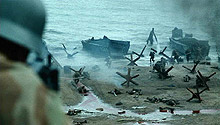 Like 2004's "The Passion of the Christ," Steven Spielberg's war epic represents the very rare confluence of extreme graphic violence and the perception of virtue. Indeed, the widely praised and extremely graphic depiction of the World War II invasion of Normandy that opens the film is maybe the best way there is for a civilian to imagine the enormity of the sacrifice that wartime soldiers routinely make for their country, and to see just how horrible and insane war truly is. The opening volleys of the battle, in which we see scores of GIs instantly mowed down by Axis bullets is as cruel and honest a depiction of what that the phrase "cannon fodder" really means – mass human sacrifice. Still, the fact that the film's violence turned out to be for the most part non-controversial was only partly a tribute to the filmmaking skill of Steven Spielberg and partly a matter that, whether it was for exploitative fun or far more serious purposes, extreme and realistic mayhem on screen was becoming just another arrow in the filmmaker's quiver. – BW
Like 2004's "The Passion of the Christ," Steven Spielberg's war epic represents the very rare confluence of extreme graphic violence and the perception of virtue. Indeed, the widely praised and extremely graphic depiction of the World War II invasion of Normandy that opens the film is maybe the best way there is for a civilian to imagine the enormity of the sacrifice that wartime soldiers routinely make for their country, and to see just how horrible and insane war truly is. The opening volleys of the battle, in which we see scores of GIs instantly mowed down by Axis bullets is as cruel and honest a depiction of what that the phrase "cannon fodder" really means – mass human sacrifice. Still, the fact that the film's violence turned out to be for the most part non-controversial was only partly a tribute to the filmmaking skill of Steven Spielberg and partly a matter that, whether it was for exploitative fun or far more serious purposes, extreme and realistic mayhem on screen was becoming just another arrow in the filmmaker's quiver. – BW
"Battle Royale" (2000)
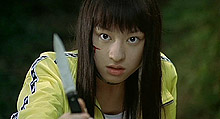 If you want to upset people with your violent film, the easiest way to do it is to involve young people. Even in its native Japan, where ultraviolent imagery is more accepted than the U.S., Kinji Fukasaku's version of a bloody futuristic fable about 15-year-old middle-school students being forced into a kill-or-be-killed final exam aroused controversy. Given that a couple of tame and socially positive episodes of "Buffy the Vampire Slayer" were left unaired for several months in the wake of near mass hysteria following the horrifying 1999 killings at Colorado's Columbine High School, it therefore was no surprise at all that not a single American distributor wanted to touch "Battle Royale." It eventually became widely available via an all-regions DVD and, watching it today, the somewhat sentimental tone of the film is surprising and the bloody violence is, while fairly strong, not half as shocking as you might assume. What really is shocking is how unshocking the premise seems to be today. We say this not because of the new 3-D reissue of the film that will play in the United States to probably no controversy at all, but because everyone seems fine with the upcoming film version of "The Hunger Games," a hugely popular young adult novel with an extremely similar premise – although we're sure with fewer arterial blood spurts. – BW
If you want to upset people with your violent film, the easiest way to do it is to involve young people. Even in its native Japan, where ultraviolent imagery is more accepted than the U.S., Kinji Fukasaku's version of a bloody futuristic fable about 15-year-old middle-school students being forced into a kill-or-be-killed final exam aroused controversy. Given that a couple of tame and socially positive episodes of "Buffy the Vampire Slayer" were left unaired for several months in the wake of near mass hysteria following the horrifying 1999 killings at Colorado's Columbine High School, it therefore was no surprise at all that not a single American distributor wanted to touch "Battle Royale." It eventually became widely available via an all-regions DVD and, watching it today, the somewhat sentimental tone of the film is surprising and the bloody violence is, while fairly strong, not half as shocking as you might assume. What really is shocking is how unshocking the premise seems to be today. We say this not because of the new 3-D reissue of the film that will play in the United States to probably no controversy at all, but because everyone seems fine with the upcoming film version of "The Hunger Games," a hugely popular young adult novel with an extremely similar premise – although we're sure with fewer arterial blood spurts. – BW
“Kill Bill, Volume 1” (2003)
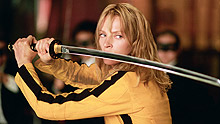 Most of the entertainment press dug this old-school and at times cartoonishly graphic revenge tale and salute to Asian action cinema, spaghetti westerns, and just about every other action genre under the sun. Nevertheless, a very vocal minority of writers drew their Hatori Hanzo swords on Quentin Tarantino, who by now was as associated with violence in the popular mind as Sam Peckinpah had once been. Critics reacted with the kind of verbal ultraviolence that recalled the horrified reactions to "Psycho" and "Bonnie and Clyde." The San Francisco Chronicle's Mick LaSalle hated the movie, but was not quite the most horrified detractor when he ended his review thusly: "Let's just call it pornography. And let's just admit it's indefensible." With arterial blood sprays that more than one viewer has compared to the fountains at Las Vegas's Bellagio Hotel, "Kill Bill" married classic kung-fu and wu xia films, the comedic effect of excess blood first mined by Monty Python, and a joyfully geeky sensibility that made it clear none of this was happening in a universe anything at all like our own. Sure, some people could get angry about it, but it's interesting how some of those horrified reviews seem to have disappeared off the Internet. No one wants to be Bosley Crowther. – BW
Most of the entertainment press dug this old-school and at times cartoonishly graphic revenge tale and salute to Asian action cinema, spaghetti westerns, and just about every other action genre under the sun. Nevertheless, a very vocal minority of writers drew their Hatori Hanzo swords on Quentin Tarantino, who by now was as associated with violence in the popular mind as Sam Peckinpah had once been. Critics reacted with the kind of verbal ultraviolence that recalled the horrified reactions to "Psycho" and "Bonnie and Clyde." The San Francisco Chronicle's Mick LaSalle hated the movie, but was not quite the most horrified detractor when he ended his review thusly: "Let's just call it pornography. And let's just admit it's indefensible." With arterial blood sprays that more than one viewer has compared to the fountains at Las Vegas's Bellagio Hotel, "Kill Bill" married classic kung-fu and wu xia films, the comedic effect of excess blood first mined by Monty Python, and a joyfully geeky sensibility that made it clear none of this was happening in a universe anything at all like our own. Sure, some people could get angry about it, but it's interesting how some of those horrified reviews seem to have disappeared off the Internet. No one wants to be Bosley Crowther. – BW
“Saw” (2004) / “Hostel” (2005)
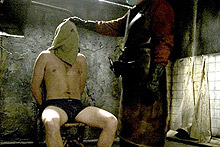 No movies so far this century have had more impact on what mass audiences are willing to sit through than Eli Roth's two "Hostel" shockers and the seemingly never-ending “Saw” franchise. Bullz-Eye’s own David Medsker seems to be of the opinion, that starting with the third film, "Saw" began to rip off “Hostel.” Indeed, the first movie in the “Saw” series, devoted to truly painful moral quandaries devised by the mysterious Jigsaw, is smarter than it is violent, perhaps earning some good will and paving the way for future installments to endlessly up their violence quotient. At least in the first couple of films, the filmmakers managed to create some engagingly horrific Easter egg hunts for Jigsaw to force on his captives. As for “Hostel,” about American students lured by their vices to fates worse than death, it's pure fun, in the loosest sense of the word, but not terribly thought provoking. You simply can’t go to Europe looking for cheap drugs and even cheaper sex without having to pay the piper eventually, and the college kids in “Hostel” find that out in the most disturbing of ways. With loads of sexy bodies leading the way to the horrors, no wonder the real college kids loved it. – RR
No movies so far this century have had more impact on what mass audiences are willing to sit through than Eli Roth's two "Hostel" shockers and the seemingly never-ending “Saw” franchise. Bullz-Eye’s own David Medsker seems to be of the opinion, that starting with the third film, "Saw" began to rip off “Hostel.” Indeed, the first movie in the “Saw” series, devoted to truly painful moral quandaries devised by the mysterious Jigsaw, is smarter than it is violent, perhaps earning some good will and paving the way for future installments to endlessly up their violence quotient. At least in the first couple of films, the filmmakers managed to create some engagingly horrific Easter egg hunts for Jigsaw to force on his captives. As for “Hostel,” about American students lured by their vices to fates worse than death, it's pure fun, in the loosest sense of the word, but not terribly thought provoking. You simply can’t go to Europe looking for cheap drugs and even cheaper sex without having to pay the piper eventually, and the college kids in “Hostel” find that out in the most disturbing of ways. With loads of sexy bodies leading the way to the horrors, no wonder the real college kids loved it. – RR
“The Human Centipede (First Sequence)” (2009) / “Martyrs” (2008) / “A Serbian Film” (2010)
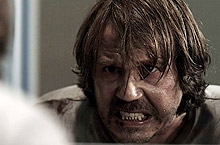 These days, European filmmakers appear to be leading the way in terms of creative onscreen extreme mayhem. Tom Six caused quite a stir – and sparked a lot of gag-inducing gags and parodies – with his tale of humans joined unwillingly (of course) by their digestive tracts. Even if the movie was pretty average, it had an audacious mad scientist construct that led to instant celluloid infamy. Two other films, however, were far superior to Six’s effort. These are the kinds of movies that once you see them, you can’t unsee, such is the power of their imagery. A meditation on religious zealotry gone mad, “Martyrs” is as brilliant a film as anything released in the last few years and features extensive, bleak scenes of torture that challenge the fortitude of even the most hardened filmgoer. “A Serbian Film” tells the story of an ex-porn actor who agrees to make an artsy adult film for a payday that will keep his family living comfortably for years to come. The clincher being that he’s not allowed to know what the film’s content is until he begins filming scenes. What follows includes incest, necrophilia, and pedophilia, the likes of which has never been depicted on film before.
These days, European filmmakers appear to be leading the way in terms of creative onscreen extreme mayhem. Tom Six caused quite a stir – and sparked a lot of gag-inducing gags and parodies – with his tale of humans joined unwillingly (of course) by their digestive tracts. Even if the movie was pretty average, it had an audacious mad scientist construct that led to instant celluloid infamy. Two other films, however, were far superior to Six’s effort. These are the kinds of movies that once you see them, you can’t unsee, such is the power of their imagery. A meditation on religious zealotry gone mad, “Martyrs” is as brilliant a film as anything released in the last few years and features extensive, bleak scenes of torture that challenge the fortitude of even the most hardened filmgoer. “A Serbian Film” tells the story of an ex-porn actor who agrees to make an artsy adult film for a payday that will keep his family living comfortably for years to come. The clincher being that he’s not allowed to know what the film’s content is until he begins filming scenes. What follows includes incest, necrophilia, and pedophilia, the likes of which has never been depicted on film before.
You can follow us on Twitter and Facebook for content updates. Also, sign up for our email list for weekly updates and check us out on Google+ as well.











